In the business world, "agile thinking" has become better known and is increasingly being applied. This presentation explains the origin of agile thinking and its content using the example of firefighting.
Agile thinking is based on the agile technique, which was developed by a group of software experts during a trip to Utah in 2001. These developers founded the Agile Alliance to improve the process of creating and delivering software. Since then, agile thinking has become an essential component of software development. Starting from the software sector, agile thinking quickly spread to other business sectors thanks to the power of technology and the universal influence of the IT industry on other companies. Agility enables companies to adapt effectively to unexpected situations. Adaptation is therefore an essential principle of agile thinking. Therefore, when we talk about "agile thinking", we generally mean the idea of reacting to spontaneous changes rather than following a fixed, unchanging plan or long-term strategy. Because unforeseen things can happen on any path to a goal ... Agile thinking is a way in which people adapt their thinking to better deal with change and uncertainty. Agile thinking is based on some fundamental principles, such as breaking large tasks into smaller pieces that can be completed quickly, bringing the project team and business owners together on a daily basis, and focusing on what's most important right now rather than sticking to a long-term plan. Agile thinking also requires the ability to learn and adapt to change, as well as developing skills such as critical and entrepreneurial thinking. Agile thinking can be applied to any project or task, not just software development. The basic ideas of agile methods and thinking are always the same. Agile principles aim to focus on the customer's needs and deliver fast, valuable solutions. This requires the ability to adapt to changing requirements and to divide the work into small, manageable steps. While working on a project, it is important that the team remains self-organized and flexible in order to quickly adapt and respond to changing needs and challenges. To achieve this, it is necessary to promote a culture of learning and continuous improvement.
1 Agile principle number 1: Customer satisfaction
To achieve customer satisfaction, you must ensure that the delivered product meets the customer's requirements and expectations and is free from defects. In the case of a fire department, this could mean that the vehicle delivered meets the requirements of the fire department and has no technical defects.
 To design a good product, you should always keep the big picture in mind and ensure that the product meets the customer's needs. In the case of the fire department, this could mean ensuring that the vehicle has the necessary equipment and functions to be able to act quickly and effectively in an emergency.
To design a good product in a short timeframe, you could, for example, divide the design process into iterations and create and test small work packages in short periods of time. You could also create prototypes to get quick feedback from customers and make adjustments. It is also important to assemble a team that has the necessary skills and resources to complete the project successfully.
To design a good product, you should always keep the big picture in mind and ensure that the product meets the customer's needs. In the case of the fire department, this could mean ensuring that the vehicle has the necessary equipment and functions to be able to act quickly and effectively in an emergency.
To design a good product in a short timeframe, you could, for example, divide the design process into iterations and create and test small work packages in short periods of time. You could also create prototypes to get quick feedback from customers and make adjustments. It is also important to assemble a team that has the necessary skills and resources to complete the project successfully.
- agile principle number 2
Plan vs. spontaneous
- What are agile processes?
- How can I plan in a more agile/flexible way?
- How can I make my decisions more spontaneously and deal with changes?
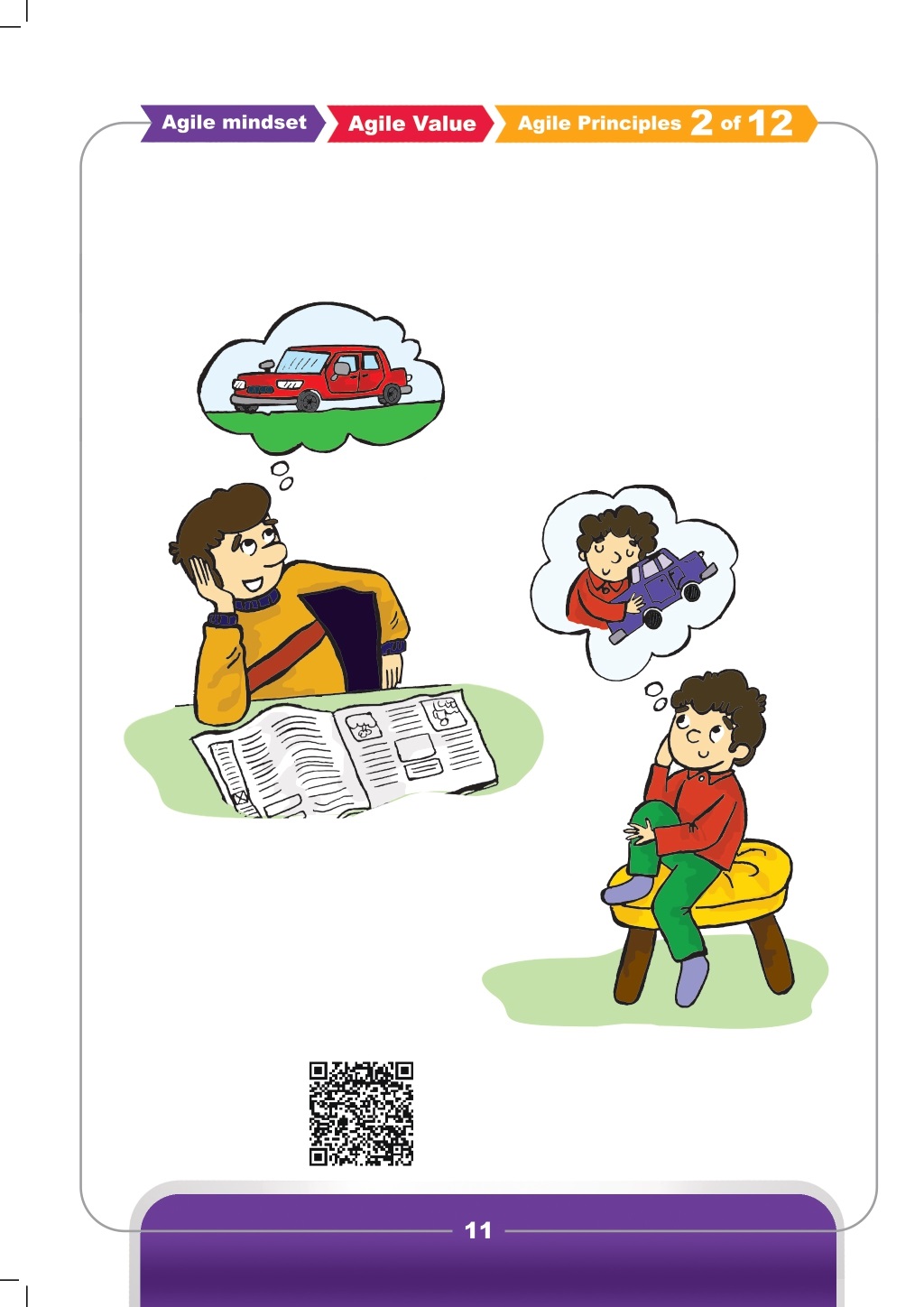 Another agile principle is planning versus a spontaneous approach. This involves adapting to the unpredictability of software development by carrying out incremental, iterative work in so-called "sprints". These sprints are completed when the time limit has expired and the development of the next phase of the project begins. To make agile processes successful, there are various best practices, such as daily stand-up meetings, sprint turnovers, sprint retrospectives and sprint time estimates. An example of applying agile principles in the fire department could be to adapt to the unpredictability and dynamics of a situation by reacting quickly to changes and taking small steps to solve the problem. For example, you could hold daily meetings to review the progress of the operation and solve problems, conduct regular feedback sessions to improve the process, and make estimates for the effort of operations to ensure that resources are used effectively.
Another agile principle is planning versus a spontaneous approach. This involves adapting to the unpredictability of software development by carrying out incremental, iterative work in so-called "sprints". These sprints are completed when the time limit has expired and the development of the next phase of the project begins. To make agile processes successful, there are various best practices, such as daily stand-up meetings, sprint turnovers, sprint retrospectives and sprint time estimates. An example of applying agile principles in the fire department could be to adapt to the unpredictability and dynamics of a situation by reacting quickly to changes and taking small steps to solve the problem. For example, you could hold daily meetings to review the progress of the operation and solve problems, conduct regular feedback sessions to improve the process, and make estimates for the effort of operations to ensure that resources are used effectively.
- agile principle number 3
It runs
- How can I design functioning products in a short time?
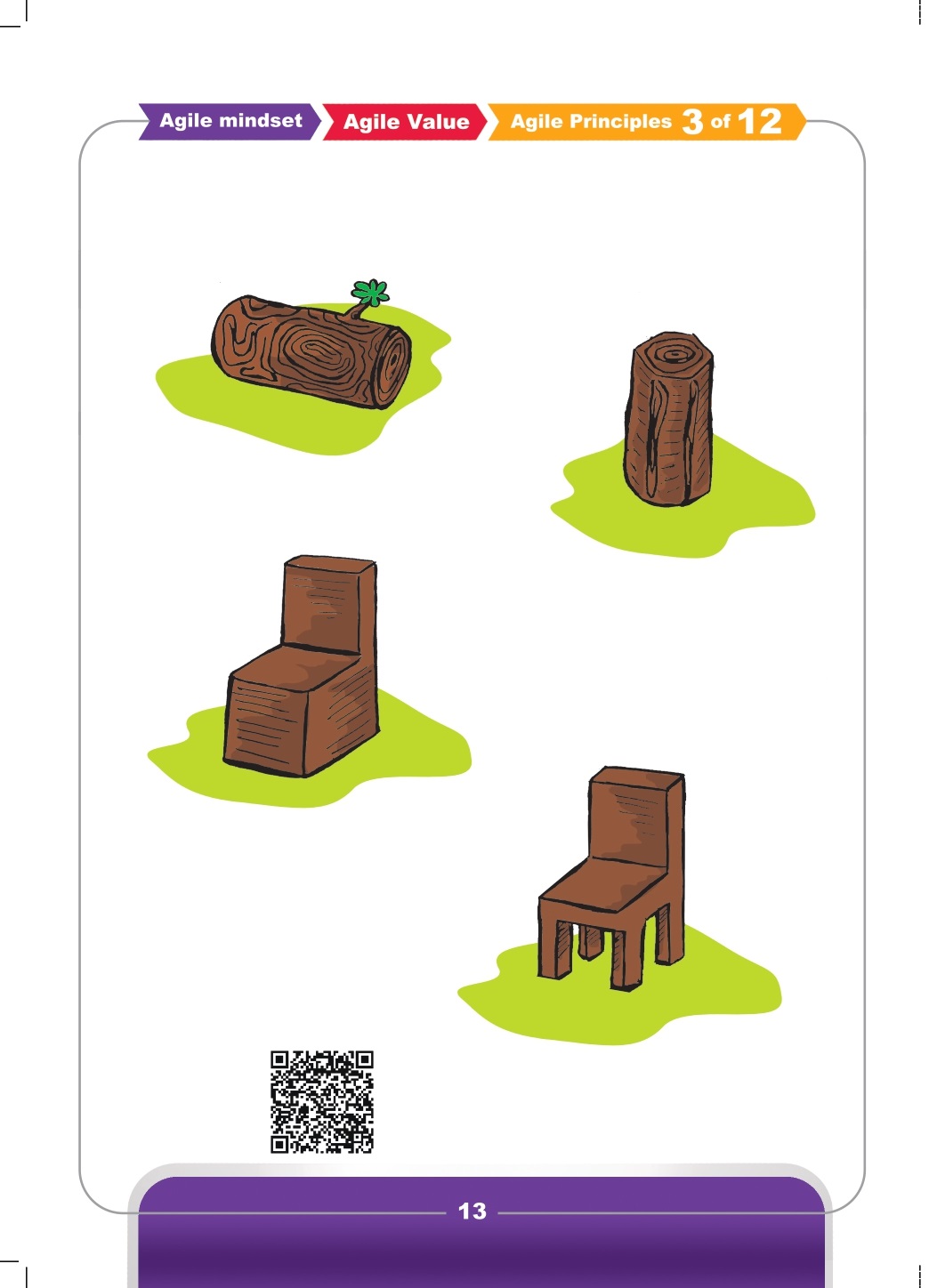
- How can I design functioning products in a short time?
The third agile principle states that the focus should be on getting work done and continuous improvement, rather than writing documents and following planning processes. An example from the fire department would be that the team needs to act quickly and effectively during an operation, rather than spending time creating extensive documentation or relying on formal meetings. Instead, they should focus on executing their tasks and have the opportunity to make improvements during the operation to become more effective. This way, they can respond more quickly to unexpected challenges and achieve better results.
- agile principle number 4
'Nerds' and class representatives
chill together
- Do experts need to communicate to make progress? Yes or no, if yes, how?
- Do developers need to communicate to make progress?
- Who are my customers?
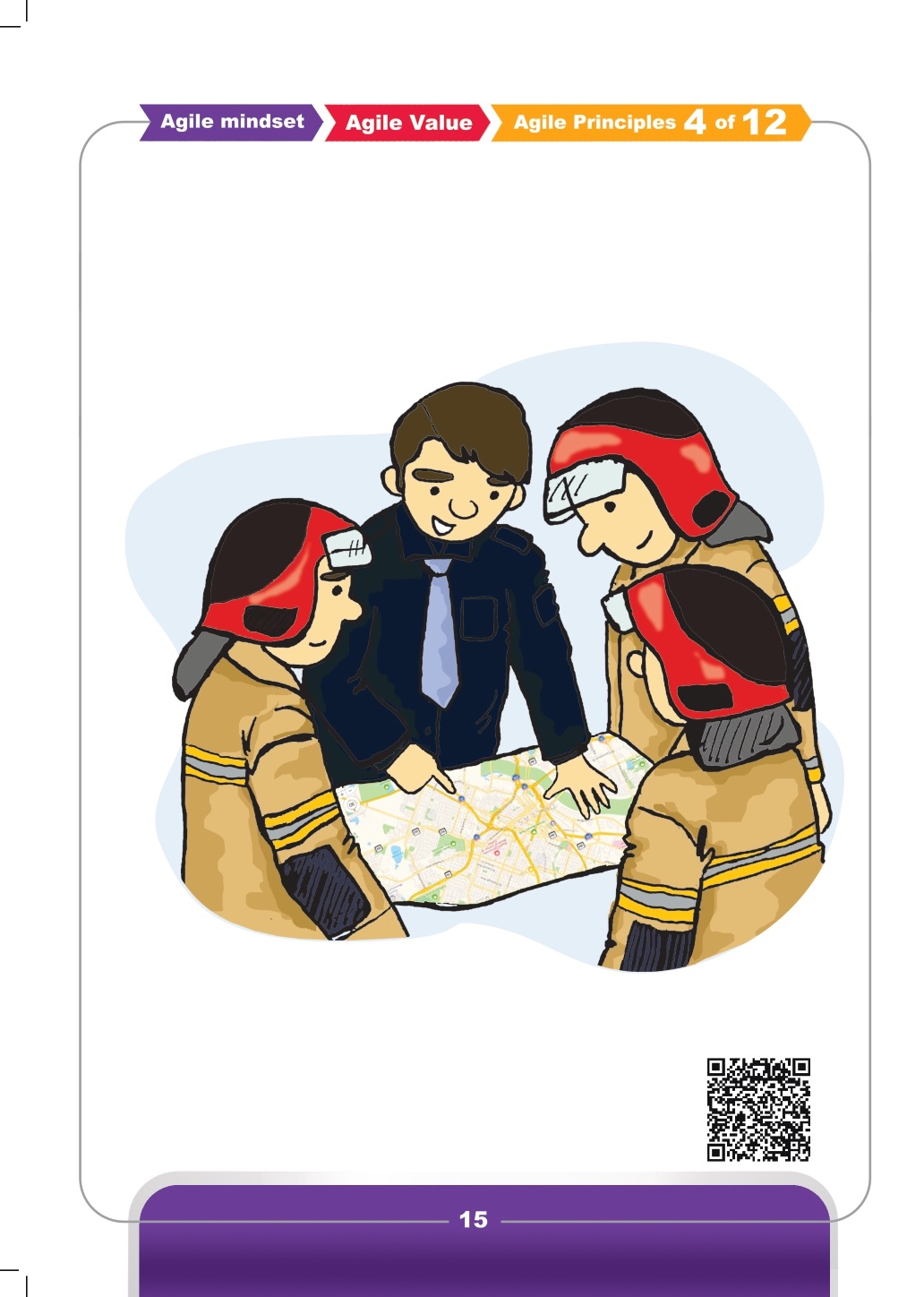
The fourth agile principle is actually: "Business people and developers must work together daily throughout the project." (Deutsch: „Geschäftsleute und Entwickler müssen während des gesamten Projekts täglich zusammenarbeiten.“) Agile methods such as Scrum and Kanban require everyone involved in the project to work closely together in order to be able to react quickly and effectively to changes. This includes business professionals and developers communicating with each other on a daily basis to ensure the project stays on track and customer requirements are met. An example of applying the fourth agile principle in a fire department project could be a team of business professionals and developers working together to develop software that optimizes fire department operations. The professionals could define the fire department's requirements and the developers could program the software accordingly. During the project, the professionals and developers would work together on a daily basis to ensure that the software meets the fire department's requirements. The fifth agile principle is: "Build projects around motivated individuals. Give them the environment and support they need, and trust them to get the job done. "(Deutsch: „Erstellen Sie Projekte um motivierte Einzelpersonen herum. Geben Sie ihnen das Umfeld und die Unterstützung, die sie brauchen, und vertrauen Sie darauf, dass sie die Arbeit erledigen.“)
- agile principle number 5
Chilled atmosphere
- Do you need a good working environment to feel good?
- What does a good working environment mean?
This principle emphasizes that it is important that employees are motivated and feel comfortable in a good working environment in order to work effectively and efficiently. A good working environment can include various factors, such as
 A positive work culture and respectful interaction with one another
Good communication and team collaboration
Clear goals and objectives
Sufficient resources and support
Flexible working hours and locations
An example of the application of the fifth agile principle in a fire department project could be that the project team promotes a positive work culture and motivates employees through regular feedback and training support. Employees would also receive sufficient resources and support to successfully complete their work, and flexibility in working hours and locations would be possible.
A positive work culture and respectful interaction with one another
Good communication and team collaboration
Clear goals and objectives
Sufficient resources and support
Flexible working hours and locations
An example of the application of the fifth agile principle in a fire department project could be that the project team promotes a positive work culture and motivates employees through regular feedback and training support. Employees would also receive sufficient resources and support to successfully complete their work, and flexibility in working hours and locations would be possible.
- agile principle number 6
Extract coal
- What does effective mean to you?
- What does efficiency mean to you?
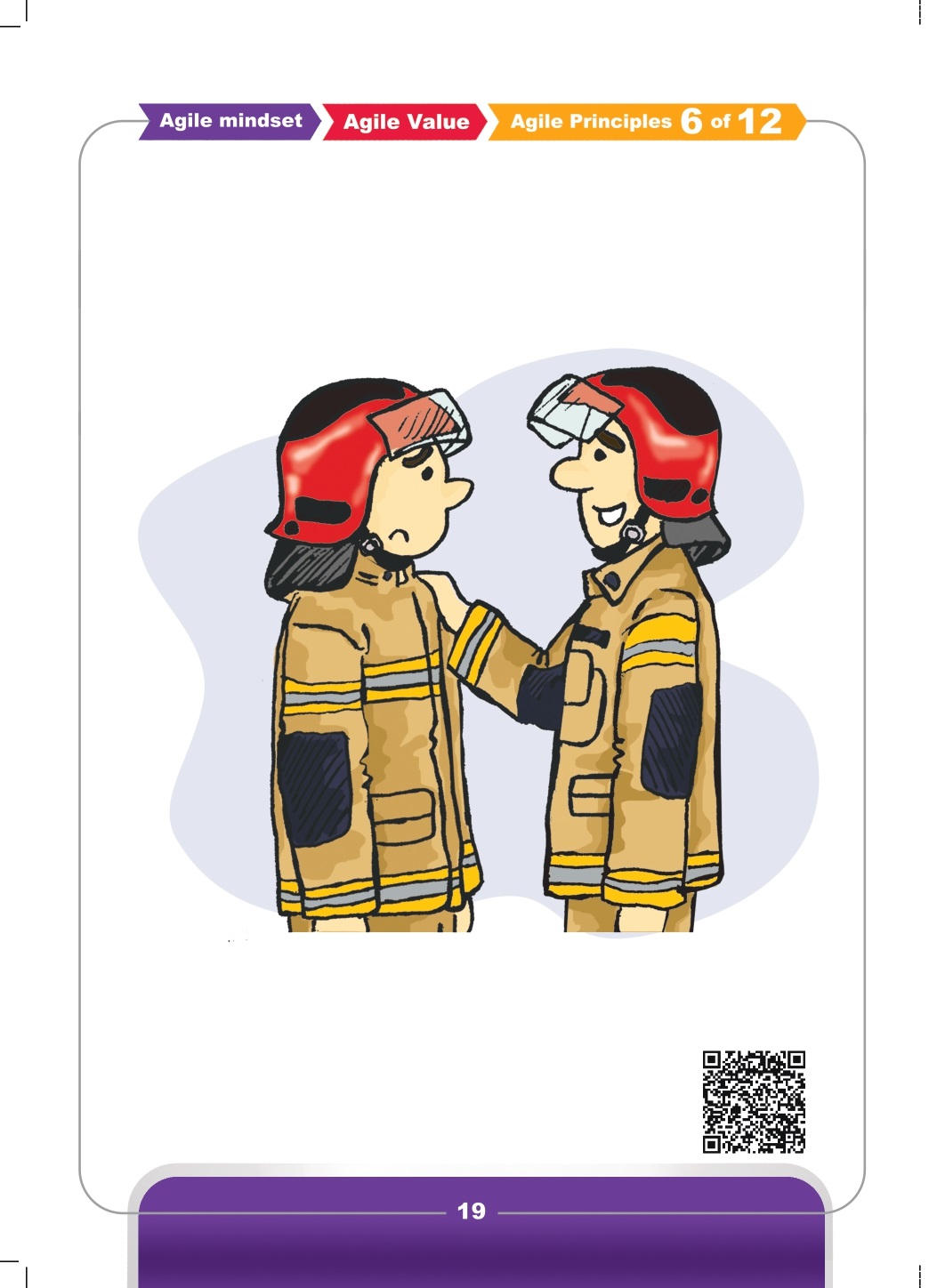 The sixth agile principle is: "The most efficient and effective method of conveying information to and within a development team is face-to-face conversation.“ (Deutsch: „Die effektivste und effizienteste Methode, um Informationen innerhalb und an ein Entwicklungsteam weiterzugeben, ist das Gespräch von Angesicht zu Angesicht.“)
The sixth agile principle is: "The most efficient and effective method of conveying information to and within a development team is face-to-face conversation.“ (Deutsch: „Die effektivste und effizienteste Methode, um Informationen innerhalb und an ein Entwicklungsteam weiterzugeben, ist das Gespräch von Angesicht zu Angesicht.“)
This principle emphasizes that face-to-face communication is the most effective and efficient means of passing information both within and to a development team. Effectiveness refers to getting the job done successfully and achieving the desired results. Efficiency refers to the fact that the work takes as little time and resources as possible.
7 Agile principle number 7 No rip-offs
- Does a better product attract more customers?
- Do poorly manufactured products lose customers? When do I gain good customers with a good product?
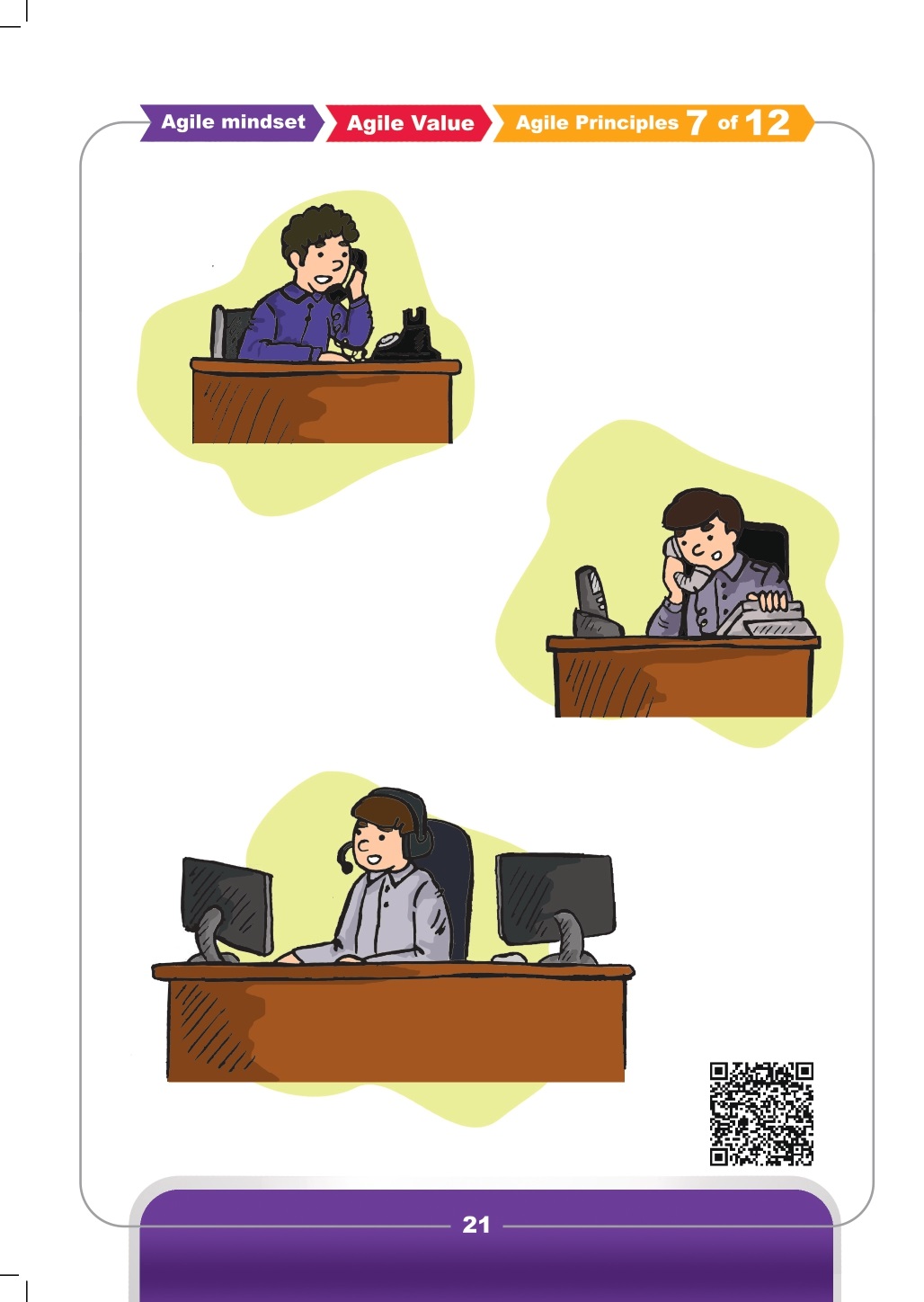
The agile principle "Working software is the primary measure of progress." (Working software is the primary measure of progress) emphasizes that the main measure of a project's progress is the quality and functionality of the delivered software. One example of the application of this principle in a fire department project could be that the project team regularly checks the functionality and quality of the software developed and ensures that it meets the fire department's requirements and works reliably. When the software has been successfully tested and the requirements have been met, it is considered "working software" and counted as progress of the project.
8 Agile principle number 8 0815 or primitive, but good
- What do you understand by sustainable development?
- Should you work at the same pace in a group project? How can your working environment influence your result or product? How can you work effectively and efficiently at the same time?
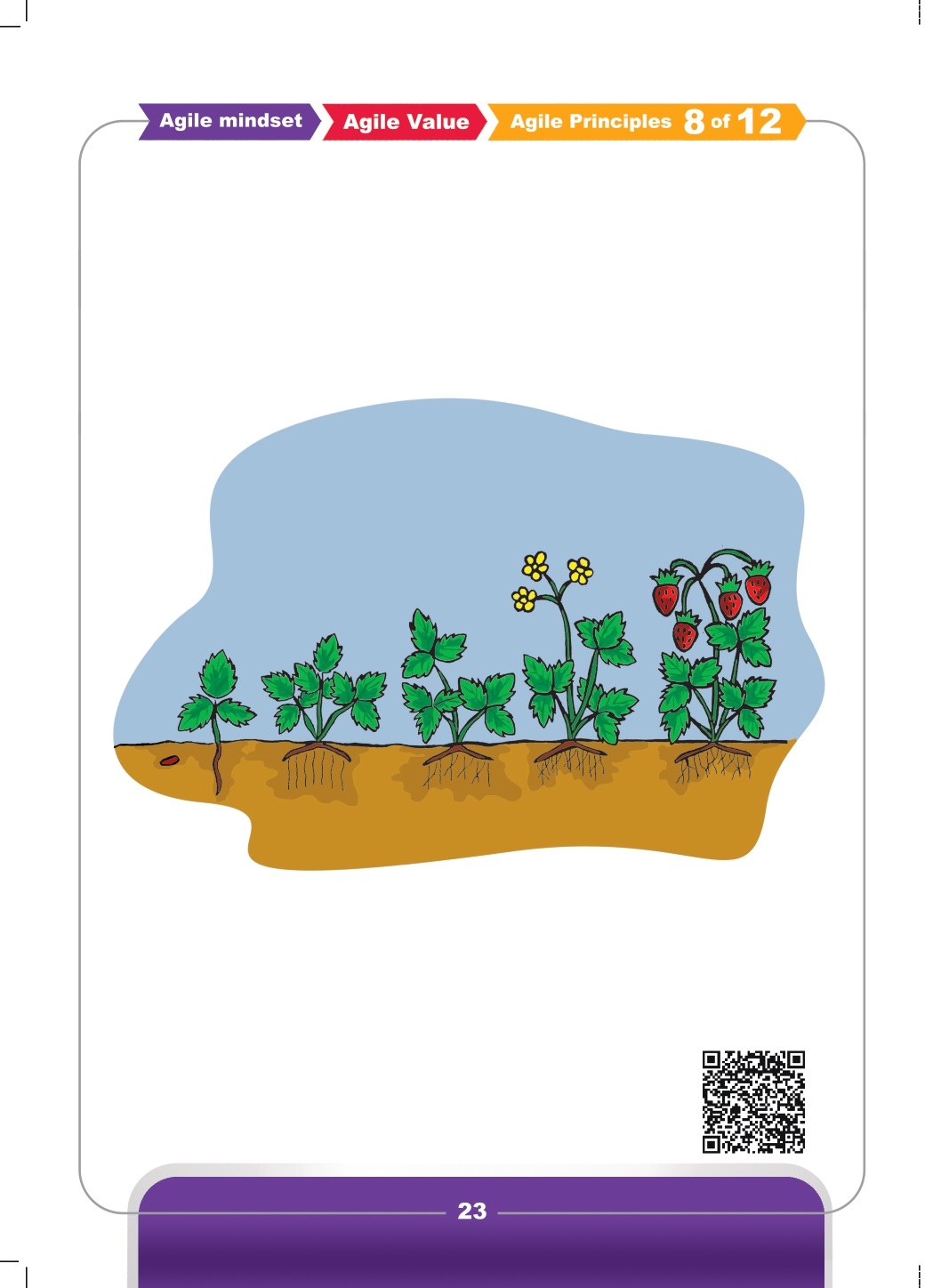
The agile principle "Sustainable development, able to maintain a constant pace indefinitely.“ (Deutsch: „Nachhaltige Entwicklung, die in der Lage ist, ein ständiges Tempo unbegrenzt aufrechtzuerhalten.“) emphasizes that agile processes help to promote sustainable development by enabling clients, developers and users to maintain a steady pace. For example, an application of this principle in a fire department project could be for the project team to introduce a regular review and retrospective meeting where employees talk about their progress and challenges and suggest improvements to the project process. This allows employees to do their work effectively and efficiently while improving in the long run. It is important to note that agile processes are not meant to speed up the pace, but rather to keep it constant in the long run. Regular communication and constant learning and improvement within the project team ensures that the pace remains sustainable and that employees can improve in the long term.
9 Agile principle number 9 The eye also eats
- Should well-functioning products also look good?
- What do you understand by the terms technical excellence and good design?
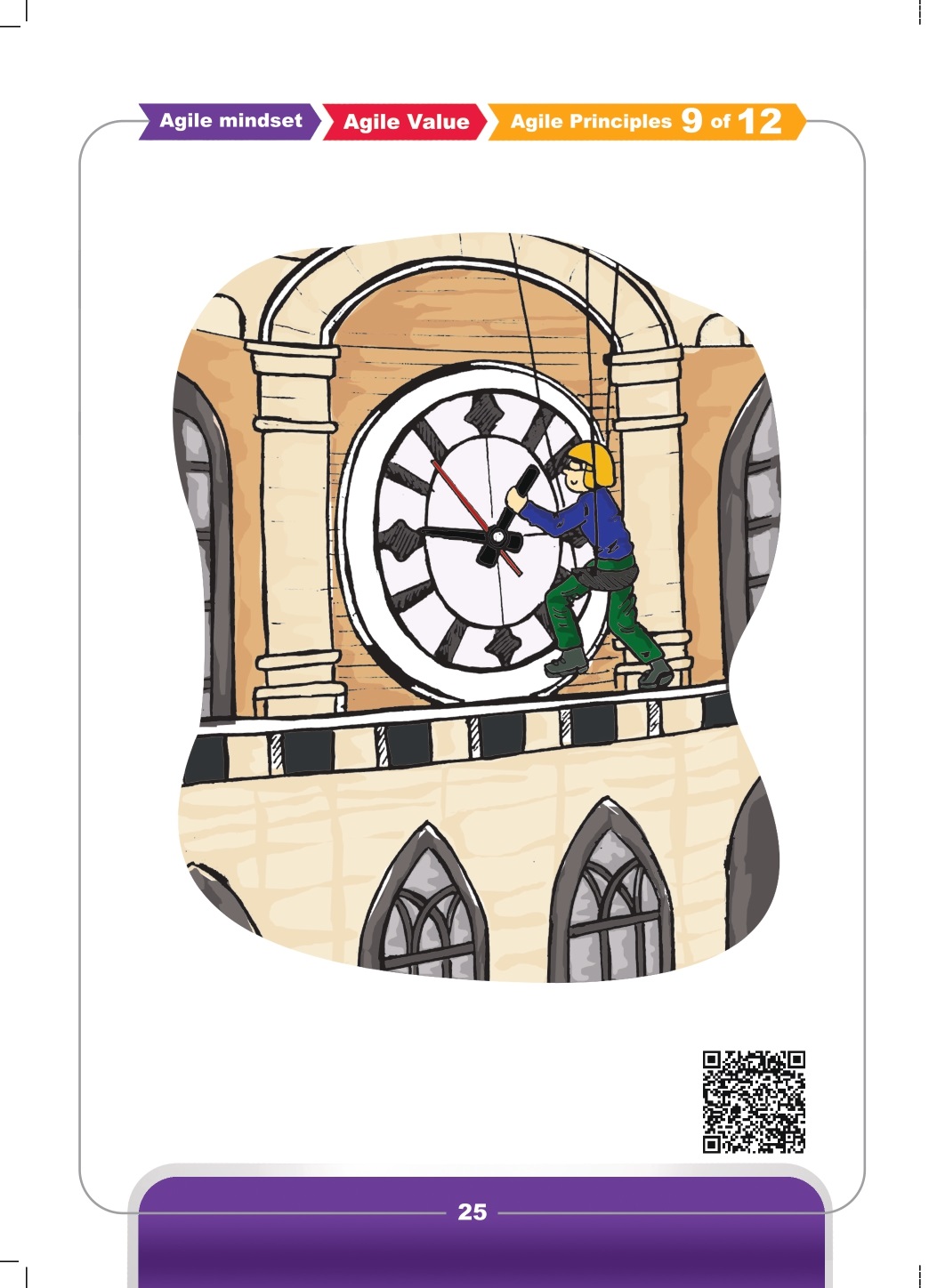
Agile principle number 9 states: "Technical excellence and good design promote agility. agility." This means that products that are both functional and appealing aesthetically aesthetically pleasing are more successful and adaptable in the long term. Technical excellence refers to the level of skills and competencies in the use of technology to create high-quality products. For example, technical excellence in a fire engine could mean using advanced materials and construction techniques are used to create a vehicle that is reliable, efficient and resilient. Good design, on the other hand, refers to the overall appearance and user experience of a product. In the case of a fire truck, good design could mean that the vehicle is visually appealing and easy for firefighters to operate. A fire truck with a well-designed user interface (UI) and user experience (UX) could, for example, include features such as clearly labeled controls, intuitive layout and ergonomic seats to help firefighters in emergency firefighters in emergency situations to facilitate its effective use. In short, both technical excellence and good design are important to create agile products that meet the needs of users and can adapt to changing circumstances. By focusing on both, technical skills and aesthetics, teams can create products that are both functional and visually appealing, which ultimately leads to higher customer customer satisfaction and success in the marketplace.
10 Agile principle number 10 Keep Calm and Keep it simple
- What do you mean by essential?
- Do you think that work not done is work not done?
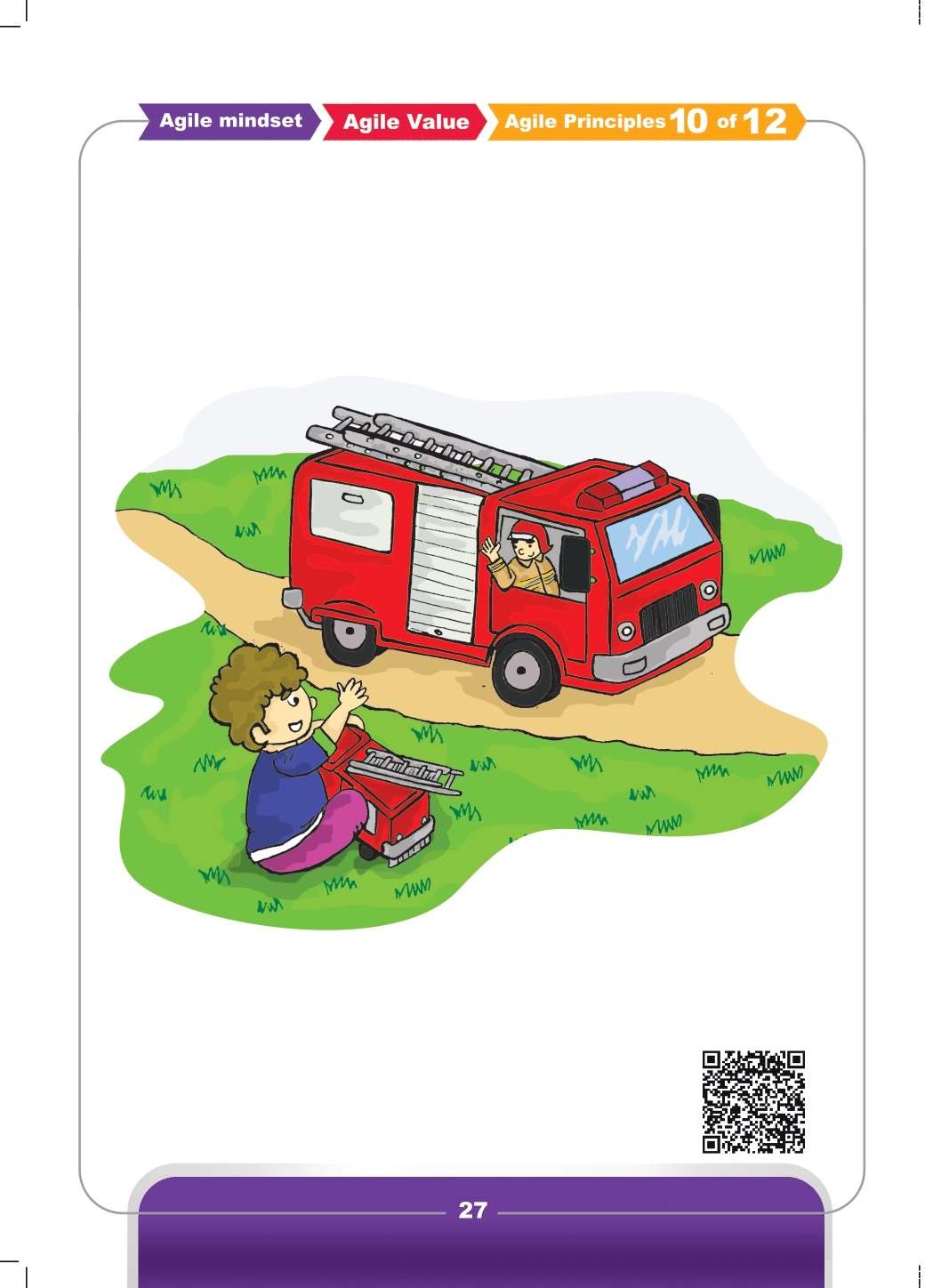
The agile principle "Simplicity - the art of maximizing the amount of work not done - is essential." (German: "Einfachheit - die Kunst, die Menge der nicht erledigten Arbeit zu maximisieren - ist wesentlich") emphasizes that it is important to focus on the most important tasks and activities and avoid unnecessary work in order to remain agile. An example of the application of this principle in a fire department project could be that the project team regularly reviews which tasks and activities are really important for the project and which are not. Focusing on the most important tasks and avoiding unnecessary work ensures that the project team remains agile and can work effectively and efficiently.
11 Agile principle number 11 Team work in the family
- What do self-organized teams mean to you?
responsibility and control?

It is also important that the project team follows simple, clear processes and workflows to minimize complexity and the amount of work to be done. By using simple and clear processes and workflows, the project team can work faster and focus better on the most important tasks. The agile principle "The most efficient and effective method of conveying information to and within a development team is face-to-face conversation." (The most efficient and effective method of conveying information to and within a development team is face-to-face conversation.") emphasizes that the best working frameworks, requirements and designs are created by self-organized teams. An example of the application of this principle in a fire department project could be for the project team to hold regular face-to-face meetings to share information and collaborate. By being able to talk and collaborate directly with each other, employees can share their knowledge and ideas and find the best solutions to the project's requirements. It is important to note that self-organized teams have a high level of ownership and employees should be able to do their work independently and effectively.
12 Agile principle number 12 Coffee in the morning?
- What are regular learning intervals for you? How can you develop a product/service step by step with the least possible delay?
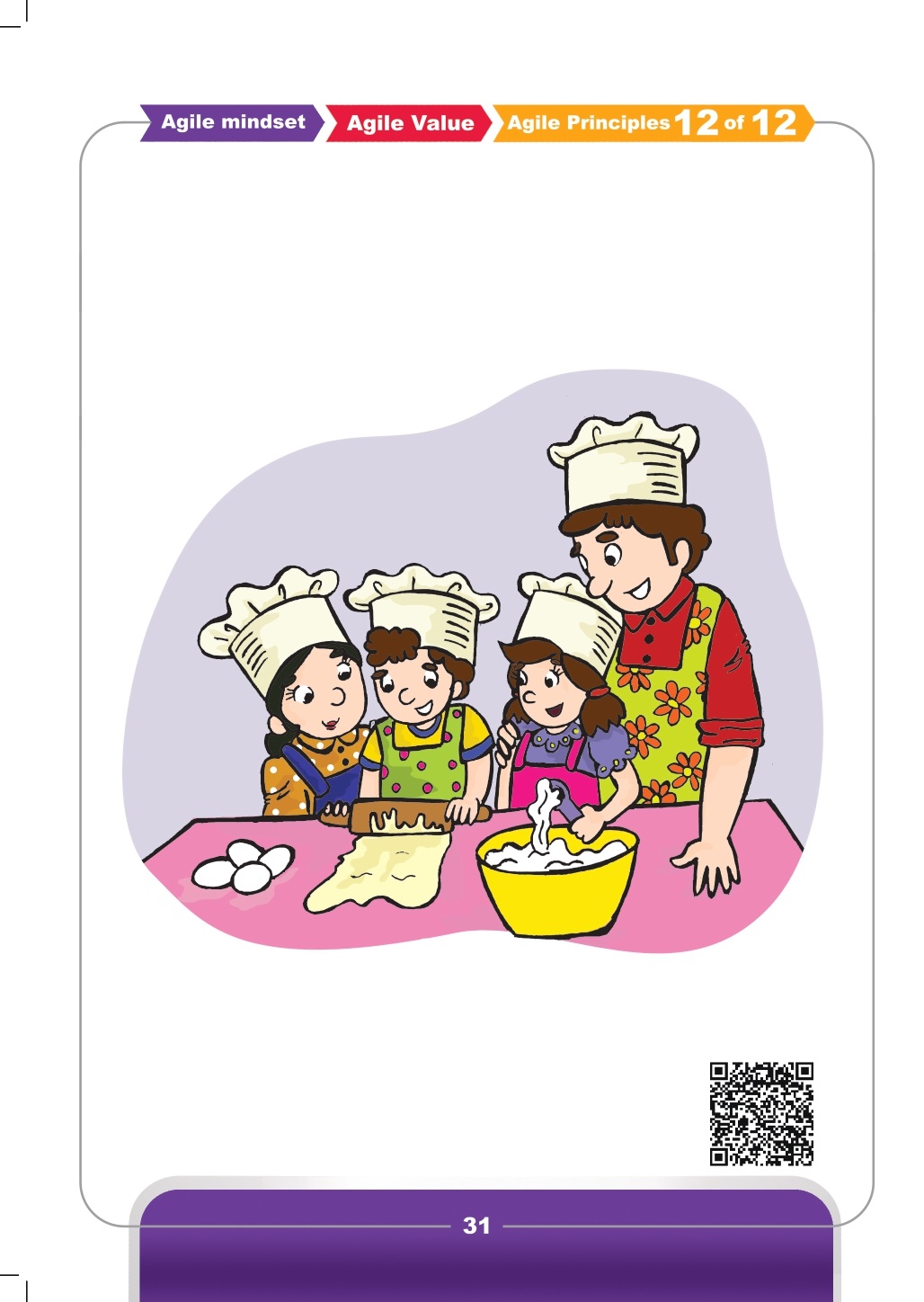 The agile principle "At regular intervals, the team reflects on how to become more effective, then tunes and adjusts its behavior accordingly.“ (Deutsch: „In regelmäßigen Abständen reflektiert das Team, wie es effektiver werden kann, und verfeinert und passt sein Verhalten entsprechend an.“) emphasizes the importance of regular retrospectives in which the team considers how it can improve its work and make it more effective.
An example of the application of this principle in a fire department operation could be that the operational team holds a retrospective at the end of the operation in which it considers which measures worked well during the operation and where there is potential for improvement. Based on the results of the retrospective, the response team could then adapt its behavior and working methods to be even more effective in future missions.
It is important to note that the retrospective is an important part of agile thinking and helps the team to continuously learn and improve. By conducting regular retrospectives, the team can ensure that they stay on top of their game and achieve the best results.
The agile principle "At regular intervals, the team reflects on how to become more effective, then tunes and adjusts its behavior accordingly.“ (Deutsch: „In regelmäßigen Abständen reflektiert das Team, wie es effektiver werden kann, und verfeinert und passt sein Verhalten entsprechend an.“) emphasizes the importance of regular retrospectives in which the team considers how it can improve its work and make it more effective.
An example of the application of this principle in a fire department operation could be that the operational team holds a retrospective at the end of the operation in which it considers which measures worked well during the operation and where there is potential for improvement. Based on the results of the retrospective, the response team could then adapt its behavior and working methods to be even more effective in future missions.
It is important to note that the retrospective is an important part of agile thinking and helps the team to continuously learn and improve. By conducting regular retrospectives, the team can ensure that they stay on top of their game and achieve the best results.
